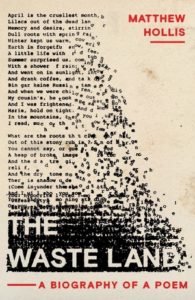Matthew Hollis explains how Eliot’s “The Waste Land” came to be
British poet and writer Matthew Hollis has told the story of a poem, arguably the most significant poem of the 20th century.
The year 1922 was an amazing year for authors and literary creations. The Shakespeare & Co. Bookstore in Paris published Ulysses by James Joyce. Sinclair Lewis published Babbitt. F. Scott Fitzgerald wrote The Beautiful and the Damned. Herman Hesse published Siddhartha. Virginia Woolf wrote Jacob’s Room. And T.S. Eliot published that poem, The Waste Land. Literary modernism was being born, and Joyce, Woolf, and Eliot had much to do with it.
Hollis centers The Waste Land: A Biography of a Poem on two men, T.S. Eliot and Ezra Pound. His account focuses on the years 1918 to 1922, what was happening in the lives of both men, and general events happening in the world that helped shape The Waste Land. (For example, World War I ended in 1918, the influenza epidemic killed an estimated 50 million worldwide from 1918 to 1919, and Britain was experiencing great labor unrest.) Eliot’s personal health had never been robust, and his wife Vivienne experienced a number of breakdowns and engaged in at least one affair, with philosopher Bertrand Russell.

Hollis explains in detail how each section of The Waste Land was created, over time and almost as individual poems. From his lodgings in Paris, Pound informally served as Eliot’s editor for the poem, and we discover an editor who did not have a light touch. What emerges is the story of a poet who was a brilliant innovator, and a brilliant editor who helped shape that innovation.
That the book is so detailed (and engagingly written) is a testament to the author’s extensive research and scholarship. He creates what seems at times a day-by-day account of not only the lives of Eliot and Pound and their circle but also the creation of the poem itself. The volume includes some 45 pages of bibliography, 44 pages of footnotes, an index, and the complete text of the first edition.

Matthew Hollis
Hollis has published several poetry collections, including Ground Water and the chapbooks The Boy on the Edge of Happiness, East, Stones, and Leaves. He edited or co-edited Strong Words: Modern Poets on Modern Poetry, 101 Poems Against War, and Selected Poems of Edward Thomas. His Now All Roads Lead to France: The Last Years of Edward Thomas won the Costa Biography Award and the H.W. Fisher Biography Prize and was named the Sunday Times Biography of the Year.
By the end of The Waste Land: A Biography of a Poem, we understand how this great work came to be. We see the interplay between Eliot and Pound. We discover the multiple circles they moved in. And when we finish reading, we’ve experienced the birth of modernism.
Related:
Robert Crawford on the Young T.S. Eliot
Eliot After The Waste Land by Robert Crawford
Photo by Raychel Sanner, Creative Commons, via Flickr. Post by Glynn Young.
How to Read a Poem uses images like the mouse, the hive, the switch (from the Billy Collins poem)—to guide readers into new ways of understanding poems. Anthology included.
“I require all our incoming poetry students—in the MFA I direct—to buy and read this book.”
—Jeanetta Calhoun Mish
- Finding Poetry in an Anselm Kiefer Art Exhibition - November 25, 2025
- Poets and Poems: Autumn Williams and “Clouds on the Ground” - November 20, 2025
- The Manuscript of “The Waste Land” by T.S. Eliot - November 18, 2025


Leave a Reply